Tai Chi Warmup Exercise for Beginners
Peng (Ward Off) – The most important Taijiquan skill & how to build it.
Peng is the most fundamental skill in Taijiquan. It’s a prerequisite for every other skill and it’s qualities should be present all the time.
What is Peng?
Peng is the physical conditioning of Taijiquan. It’s the strength & fluidity that comes from doing the hard physical work and building a Taiji body. The “Song of Peng” describes the results of this type of training. In this article we’ll break down each aspect of peng in detail. Then over the next few months we’ll add a bunch of exercises to each section so that you can begin doing the hard work to build this quality.
The Song of Peng.
Peng is like water buoying a moving boat.
First one must sink Qi to the Dan Tien,
Then set the head upright as if suspended from above.
The Whole body should be full of elastic energy,
Opening and closing in just one moment.
Even if there is a thousand pounds of force,
It is easy to float without difficulty.
Like water supporting a moving boat.
When we make contact with the opponent we must be like water supporting a moving boat. There is no space between the water and the boat. The water has a lot of potential power that could effect the boat and yet the boat can enter the water and move freely throughout.
When the opponent moves into our space we must adhere to them. Like the water, we accept them into our space and fill in any gaps between us and them. We do not compromise our ability to deliver power and we do not impede their movement.
This requires a very supple body. We must train our core, hips, and shoulders to flow and move independently of each other. We must remove stiffness from our body and strengthen the weak areas that create tension.
- Shoulder Roll & Shift – for loosening the shoulders and waist
Sink the qi & suspend the head
Sinking the qi is critical in allowing your upper body to loosen enough for good peng.
- Breathe in, raise and expand the chest & back
- Relax and breathe out. Feel the sinking and settling down through your body as you do this.
Repeat this exercise until you are comfortable with this sinking sensation throughout the body. Practice until you can let go and sink quickly without relying on the breath to help you feel it. Keep practicing until this relaxed sunk state becomes a habit.
Leg Strength
As you relax and let go, your weight settles downward and the pressure on your legs increases. Your legs will tense to support the additional pressure and that tension will try to creep back up into your hips, waist, and lower back.
To have peng we must build enough leg strength that our lower body stays relaxed as we sink. Especially when we are in low stances like snake creeps down or when we must stand on one leg.
Suspend the Head
Extend upwards through the spine and out the top of the head. The trick is to keep your mental focus on sinking downwards while pushing up.
Imagine there is a string coming from the top of the spine. So as you sink the head is supported by the string. You should feel the soft tissues and the joints stretch slightly between the downward pull of gravity & the upward support of the string.
Use this imagery to help you extend the spine upward while keeping your mental focus on sinking downward.
The body is filled with springlike energy, opening and closing in an instant.
This is described as being inflated like a rubber ball, springy like a coiled spring, and like a bow that is bent and released.
To build this quality we strengthen our connective tissues by stretching, extending, and twisting them.
Opening is expanding and stretching. Closing is squeezing and contracting.
Strengthening the connective tissues allows us to open and close quickly and fluidly. Opening and closing is also a good way to strengthen the body and build the elastic quality.
Float without difficulty
By strengthening the body with peng we become very strong, relaxed, and fluid. This becomes our natural state so that no matter how much ferocity an opponent brings to us, we continue to flow with ease. And no matter how much pressure we are placed under we adapt calmly and quickly as needed.
Don’t Stop – Tai Chi Rule 10
A long boxer is endless, like the current of a great river.
長拳者,如長江大海,滔滔不絕也
– The Theory of Taijiquan by Zhang Sanfeng
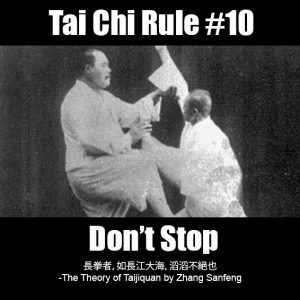
We stop moving a lot more than we realize.
Spend time doing your drills and form excruciatingly slow. This will make pauses in your movement easier to catch.
Most importantly, do push hands and other partner drills slowly. The slower the better. Resist the urge to speed up when your partner starts to catch you or when they start to escape your push.
Focus on going slightly slower than your partner. This way you are forced to improve your positioning, timing, & internal skills to counter or catch them.
Practice 24/7
Start doing Taijiquan before you enter your practice space. Keep doing it after you leave. Wake up practicing Taiji and fall asleep while still practicing.
Set an alarm for regular intervals. Every hour, every two hours, every 30 minutes. Whatever works for you. Take one movement or drill and practice it every time the alarm goes off.
Endless Possibilites
Tai Chi at it’s core is based on 8 skillsets and 5 steps that are combined and mixed to provide infinite possibilities including all the forms & styles of Tai Chi we see today.
The 8 skills of Tai Chi
- Ward-off (Peng)
- Roll-back (Lu)
- Press (Ji)
- Push (An)
- Pull-down (Tsai)
- Split (Lieh)
- Elbow (Chou)
- Shoulder (Kao)
The Five Steps
- Advance
- Retreat
- Look to the left
- Gaze to the right
- Central Equilibrium
How to Differentiate Substantial and Insubstantial – Tai Chi Rule 9
Differentiate substantial and insubstantial in order to string the body together without any breaks.
虛實宜分清楚,一處有一處虛實,處處總此一虛實,周身節節貫串,無令絲毫間斷耳。
The Theory of Taijiquan by Zhang Sanfeng
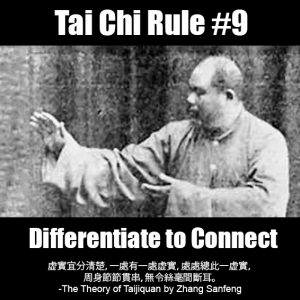
The key is to remember that substantial & insubstantial coexist in the same space as two distinct qualities of the same thing. At first we will do some exercises that appear to separate substantial and insubstantial. This is a stepping stone. It’s not entirely accurate.
Shifting the weight
Stand in a neutral stance. Shift all your weight to the right leg. Relax and wiggle the left leg. Feel the weight, pressure and fullness of the right leg (substantial) and feel the loose light emptiness of the the left leg (insubstantial.)
Slowly shift your weight to the left leg and feel the change in substantial and insubstantial from one to the other.
String the Legs Together
To do this well your knees, hips, and ankles must be relaxed and connected. Imagine your joints are strung together like a marionette. As the upper body shifts from one side to the other, your lower body moves because it is connected. Keep the joints loose and relaxed. Feel how the looseness of the hips allows the weight to shift easily from one leg to the other.
Get a feel for this connected looseness. Then integrate it into the connected movement principles you learned in Tai Chi Rule 1 and Tai Chi Rule 5.
As you work through the exercises below keep in mind that this body connection is a key part of what is happening.
Empty and Full
Continue shifting your weight back and forth slowly. Feel the sensation of weight pour from one leg to the other as one leg empties and the other fills.
As you walk your legs are always in a state of transition. Partially full & empty, shifting back and forth. Pay attention to this as you walk through your form.
Once you become familiar with this sensation of empty and full, begin looking for it in your arms and then in the rest of your body. It will be much more subtle. Take the time to feel it and differentiate.
Separate Upper and Lower
Relax and let your weight sink into the lower body. Everything above the waist should be light and fluid. While everything below the waist should feel very full and heavy.
Practice this enough that the upper body is very light and the lower is very heavy. Make sure you are still applying Tai Chi rules 1, 4 & 5.
Substantial & Insubstantial at the same time.
When done correctly the weight and power of the lower body will be transmitted through the light softness of the upper. At an intermediate level you can begin to differentiate between the soft emptiness of the upper body and the heavy power that resides within the emptiness.
With practice, let the heaviness drop down out of the legs so that the entire body is soft and light from head to toe and begin to feel the weight and power that resides within the softness.
For now, focus on the beginning and get really good at distinguishing between empty and full with the shifting of your weight. The better you get at feeling the subtleties of what’s happening inside your body the better you will be at differentiating substantial and insubstantial.
Every action has a reaction – Tai Chi Rule 8
If there is up there is down. If there is left there is right. If there is forward there is back.
有上即有下,有前則有後,有左則有右。如意要向上,即寓下意,若將物掀起而加以挫之之力。斯其根自斷,乃攘之速而無疑。
– The Theory of Taijiquan by Zhang Sanfeng
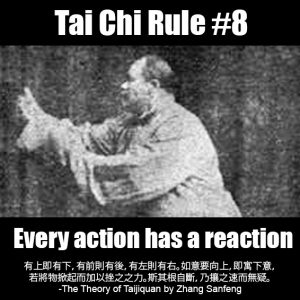
In Tai Chi we are constantly combining things that appear to contradict each other.
In doing so we find that what appears to be a contradiction is in fact two sides of the same coin and one cannot exist without the other.
You step forward by pushing backward with your foot. To push to the right you must apply force to the left.
The common analogy is a tree. The taller the tree the larger the root system required to support it. The larger the root system is the bigger the top must be to collect enough sunlight to nourish the roots.
Instead of trying to throw an opponent where they are strong, you can attack their support and they will fall all on their own.
Solo Exercise
Do the Yi intention exercises from Rule 7. Fill the 3 foot radius around you with Yi and when you step to the left make sure that the right side remains full the entire time. Don’t let the Yi shift to the left with your step.
Work on this with all your Tai Chi movement and make sure that you are filling the whole space the entire time.
You can also play with the Yi Leads the Movement Drill.
Instead of letting the Yi move ahead of where you are going, let it move in the opposite direction.
While working on rule 7 you might of thought of Yi as a magnet that pulls your body towards it. Now switch that polarity in your mind and think of Yi as a magnet that pushes your body away from it.
So if you wish to step forward the Yi shifts behind you and pushes you away from it.
How to move with Intention (Yi) – Tai Chi Rule 7
Move with purpose, not just the surface.
凡此皆是意,不在外面,
– The Theory of Taijiquan by Zhang Sanfeng
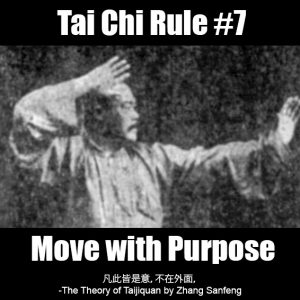
1. Every movement should be done deliberately with awareness and purpose behind it. Nothing should superficial or done for the sake of appearance or repetition.
2. Every principle and movement has a reason for existing. You must understand why it exists and what it is used for.
3. Move with Yi.
The most common translation of this passage is “Move with Yi (intention), not externally.” or some variation.
It is correct, but it can easily mislead beginners.
意 (yi) means different things depending on the context. It can mean purpose, significance or meaning, as I’ve interpreted it in parts 1 & 2 above.
However, in martial arts it often means a very trained and focused thought or intent. It is a sensation that can be felt and manipulated to great effect, similar to Qi.
Many arts use this. Internal, external, fine arts and most athletes. They may talk about it as focus or being in the zone.
For example, Xingyiquan puts a lot of time into training a very powerful and focused Yi that leads every action and cuts through the opponent. When a Xingyiquan practitioner stares at you from across a room you should feel their gaze cutting through you.
This meaning of Yi is often focused on and students will work to put it into every movement of their Tai Chi.
However, Tai Chi strategy is about disappearing & being inscrutable to an opponent.
A highly focused intent is something even an untrained opponent can sense. This becomes a form of telegraphing that will prevent you from using Tai Chi’s most fundamental strategy.
Tai Chi trains the Yi, it can focus the Yi, but it almost never uses a focused Yi.
Training the Yi
It’s much easier and faster to train something you can feel.
A focused Yi is much easier to feel than an unfocused one.
Tai Chi prefers an unfocused Yi for that very reason.
As a beginner we must use a focused Yi for a bit but always keep in mind that this is a crutch we are using to jump start the process. Don’t let it become a bad habit you must spend time untraining.
Yi (Intention) drill
Use your warm ups to get the Qi flowing then stand in a neutral posture.
Bring all your focus to one hand.
Slowly begin your Tai Chi set. Keep all of your attention focused only on your hand. Feel every centimeter of your hand. Experience every millimeter of movement.
If the rest of your body looks like garbage, ignore it. Bring the focus back to your hand so that you don’t even know what the rest of your body is doing.
As you do this the Qi sensation should get stronger in your hand and with practice you will get a sense of what the focused Yi feels like.
Once you get the hang of this, expand your focus to both hands.
Then do a set where the focus includes your entire arms.
Then focus only on the legs, then the entire torso.
Then do a set where the focus is on the entire body.
Then do a set where the focus includes a 3 foot radius around you.
Yi Leads the Movement
Go back to focusing on a single hand.
Instead of following the hand with your Yi, let the Yi get slightly ahead of your hand and let your hand be drawn to it.
Once you get comfortable with this, repeat all the stages of the previous exercise with the Yi now leading your movement.
Just an exercise
This exercise is meant to help you feel and build your yi.
Make sure that at each stage your Yi fills the entire area. If you find your mind darting around within the area of focus then you need to focus on filling a smaller area.
Shen follows the Yi
Remember that while you are working this exercise you are violating Rule #3 Draw the Spirit Inwards because the Spirit is drawn to where you focus your Yi.
That’s ok for now. Building a strong Yi is essential and this work will make manipulating Spirit that much easier and more effective later.
Don’t Skip Leg Day – Tai Chi Rule 6
If your timing and position are not excellent and your body is not unified. Your waist and legs need more development.
有不得機得勢處,身便散亂,其病必於腰腿求之,上下前後左右皆然。
– The Theory of Taijiquan by Zhang Sanfeng
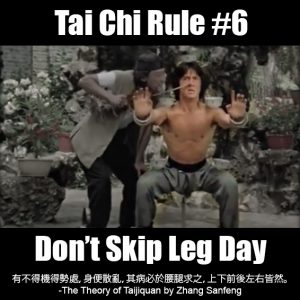
This rule is easy to overlook. A lot of people underestimate it because it appears to be a simple explanation of the what happens when you don’t do Rule 5 properly.
Yet, it is the single most common error I see.
Any error in the lower body is magnified through everything else you do.
There can be a number of issues here but the most common and fundamental one is:
Not enough leg strength.
Tai Chi is not about strength and this is exactly why you need it.
Tension is a weakness that will prevent the coordination necessary for Tai Chi Rule #5.
If you are stronger, less of your total strength is needed for standing and moving, so more of you can be relaxed.
You need two types of strength. Train both, they will help each other.
Muscular strength
Do squats.
On youtube you can find thousands of variations on the basic squat for every fitness level.
Find one appropriate for you and get to work.
Tendon and ligament strength
The stronger these are, the more you can relax your muscles, and the better your Tai Chi will be.
Squats will help. You can find specific exercise for this on youtube as well.
Use them.
Relaxing for strength drill
Stand in a Tai Chi posture and relax.
Use the Root at the Feet drill to get the feeling of relaxing and letting your body weight sink downwards into and through the legs.
Now relax deeper.
Breath in, relax and sink.
Feel the sensation of sinking inside your body. Your physical stance should only settle slightly.
Breath out, relax and sink even deeper.
As you relax deeper you should feel more and more weight on the legs.
Relax until the weight on your legs is excruciating. Relax deeper.
If the weight on your legs is not excruciating, you are holding too much tension.
Relax your lower back, relax your hips, relax your shoulders, relax your thighs, calves, feet, etc…
Do this while stepping.
The weight crushing down through your legs should be enough that you cannot lift a leg until you transfer all your weight to the other one.
As you step make sure you do not tense and bring some of the load off of your supporting leg.
Do this with your form.
Keep proper leg alignment!
You are putting a lot of stress on your legs.
Do this in short sessions at first. Build into it slowly.
It will take time for your legs to get stronger.
Pay close attention to the proper leg alignment in Tai Chi Rule 5. There should never be any awkward pressure or pain in the knee.
The lower body moves as one. With precision and timing – Tai Chi Rule 5
Movement is rooted in the feet, generated in the legs, controlled by the waist, & functions through the fingers. The feet, legs and waist must always act in unison, in order to move with precision and gain an advantage.
其根在腳,發於腿,主宰於腰,行於手指,由腳而腿而腰,總須完整一氣,向前退後,乃能得機得勢。
-The Theory of Taijiquan by Zhang Sanfeng
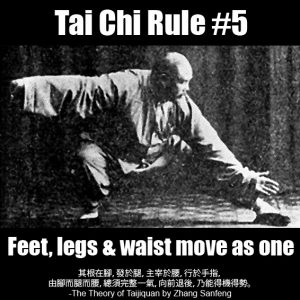
This describes the basic functions of the lower body. The feet provide the base & stability, the legs generate the movement, and the waist directs that movement. All this must be coordinated as one.
Note: Some translations use the term Qi (energy) or Jin (force) instead of movement. All are correct. Focus on movement first and the others will come.
Root at the Feet Drill
1. Sit down. Lift your feet off the ground and roll them in all directions. Slow and gently. Twist and turn them. Move your ankles and toes through their fullest range of motion and experience what that feels like.
2. Stand up. Tense your feet then relax them. As they relax, feel them spread out and conform to the surface you are standing on. Repeat this several times with deep relaxation each time.
3. Continue repeating step 2. Begin adding the ankles, then the calves and eventually the entire leg into the tensing and relaxation. Each time you relax let the bottom of the foot expand and open. Let gravity pull the tension, weight, and Qi down your legs and out the bottoms of your feet. Let that sensation continue downwards as deep as it will go.
4. Now include the hips, waist, lower back and belly. Bending the knees and leaning forward slightly may help.
5. Relax. Let the feet expand and press into the ground. Let the weight of your body sink and settle down into and through your feet.
6. Keep your feet relaxed and firmly pressed into the ground by your weight. Begin to move your ankles. Slowly rock your body in a circle using your feet. The knees and waist may need to adjust a little for balance but keep that to a minimum. Get the largest range of motion you can using just your feet and without falling over.
If you feel top heavy, relax. Let that weight sink down into and through the feet.
Directed by the Waist Drill
1. Stand with feet shoulder width apart. Bend your knees and bring your hips under you as if sitting down. Drop about 3 – 6 inches below your normal standing height.
2. Make sure your feet are pointed forward or only slightly out and make sure your knees are lined up with your feet. This should be a comfortable position with no twisting or unusual pressure on the knees.
If you have physical issues that require a different toe/knee alignment, then adjust as needed.
3. Make sure your knees do NOT twist. This is very important. The knee is meant to bend and straighten. It is NOT meant to twist. Your toes, knees and hips should all be lined up and they should STAY that way during this ENTIRE exercise.
4. Keep your hips forward. Slowly turn your upper body and look to your right. Then your left.
Most of the twist should come from your belly and lower back (this is what we are calling the waist) above your hips. The hips, pelvis, knees & toes all stay facing forward with no twisting.
5. Go slow and pay attention to what this feels like. Bend your knees more and experiment with different stances. Wider, narrower, one foot forward. Expand your range of motion without letting your knees twist.
Generated at the legs
The legs are very powerful so they do the heavy lifting.
However, the knees only bend and straighten. They never twist. The knee can move up and down forward and back. It should never twist or move side to side.
The knee can be behind the toes or in front of the toes. It should never be inside the toes or outside them.
How to turn the foot
Sometimes a stance will require that the feet point in different directions so you will need to rotate the leg.
This rotation should come from the hip.
Opening the hip exercise.
1. Stand next to a stable wall or railing and brace yourself with one hand.
2. Raise one leg off the floor so that your knee and hip are both at 90 degree angles and your thigh is parallel to the floor.
3. Slowly swing your leg outward away from your other leg. Feel your hips open in the front and close in the back.
4. Bring your leg back the other way so that is crosses in front of your body. Feel the hips close in the front and open in the back.
Slowly and gently expand your range of motion and get a feel for the movement.
When you need to turn your feet in Tai Chi forms or movement remember what this feels like and turn from the hip without any torque on the knee.
Moving as a Unit.
This will require time and practice.
Practice your form without using your hands. Just focus on your stances and stepping. Pay attention to the feeling of your feet on the floor and moving from the ankles. Twist and rotate from the waste.
As you get more comfortable with this make sure everything is moving at once. Lookout for any awkwardness in movement and any areas that are not a coordinated part of the whole.
Chan Si Jin & Spirals
Spirals are an integral part of Taijiquan and should always be present throughout the entire body.
If you have not trained in this yet don’t worry about it. We’ll get to it later.
The spiral principles and the straight alignment of the knee coexist in harmony. One does not negate the other.
As you work your spirals, make sure it is allowed to pass through the leg without putting any twisting pressure on the knee.
This may seem counter intuitive but with practice the spirals will help you better connect the lower body, get more power from it, and make it easier to keep proper alignment that protects the knee.
How to Practice Perfect Tai Chi – Rule 4
No defects, no bumps, no stops and starts.
無使有缺陷處,無使有凹凸處,無使有斷續處。
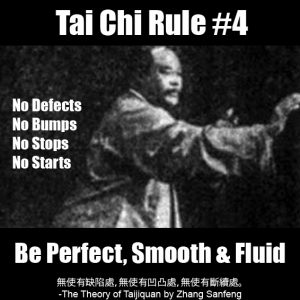
No Defects
Whatever you do regularly becomes muscle memory.
If you practice Tai Chi with an error it will become a trained error that is hard to untrain.
But you can never practice 100% perfectly.
So the trick is to stay vigilant. Always include a form of error correction in your practice and seek out new ways to check for errors you may not be aware of.
Practice slowly and deliberately so that you have time to spot errors as you are making them and fix them.
Use mirrors, video, and friends to analyze and find errors.
Take time before practice to visualize what you are going to do. Take time afterwards to analyze what you did and what you need to correct.
Remember there are always errors – if you can’t find them you need to improve your skill of perception and error detection.
No bumps
Your posture should not have sharp angles, protrusions or indentations. These create weakness in your posture that limit power, cause injury, and can be exploited by an opponent.
Defects like this will also limit Qi flow. If you’re working on stirring the Qi during your set then you should feel that sensation grow stronger as you fix these defects. If you feel the sensation of Qi diminish there is likely an error in posture or tension that needs to be fixed.
This also applies to movement.
Keep in mind that there are times a movement or posture may appear to break this rule but does not.
Quick posture fix: Inflation drill
Here is one way of adhering to the “no bumps” rule. (there are others.)
Note: With each step you should breath in and out multiple times until you get a feel for the sensations being described.
1. Stand in any Tai Chi posture.
2. Breath in slowly and deeply. Relax & feel your belly expand as your diaphragm pushes it downwards to make room for the air in your lungs.
3. Pay attention to that feeling of inflation. (relaxation, pressure, and expansion combined)
4. Breath in again. This time expand that feeling of inflation to the entire torso. Belly, Chest & Back. To inflate the lower back properly you may need to bend your knees and roll your hips under you as if you are about to sit down.
5. Imagine you are a beachball. Breath in and expand the feel of inflation to your arms. Feel your shoulders, elbows, wrist and fingers gently expand.
As you inflate the upper body your posture should become bigger and rounder. The inflation should prevent any joint from having a sharp angle while at the same time preventing them from being locked out completely straight.
6. Do this again and expand the inflation to your lower body. There may be a temptation to stand up taller as you do this. Instead, bend the knees and sit down a little lower to help the feeling of expansion go outward. Side to side and front to back.
At first you will expand with the breath from a single point in the center of your body. As soon as possible, start thinking of this expansion as happening from every point simultaneously in every direction.
Take your time and focus on each joint individually. Feel it expand from it’s center in all directions. Then a do this everywhere all at once.
Move while inflated
Move through your form with this inflating quality.
You should find that this makes all your postures and moves big, smooth, and round. It prevents any sharp angles.
Remember to stay soft and relaxed. The inflation should be felt everywhere but always soft and gentle. Never forced.
This large inflated ball idea is a very important concept in Tai Chi. Though some systems will emphasize it more than others, it is always present to some degree and there are many intermediate and advanced skills that will use it in all kinds of ways.
Practicing this quality is also one way of doing “large frame” Tai Chi. A method that is most famously popularized by Yang Chen Fu, one of the first and most prolific Tai Chi teachers in the 1920’s.
Intermediate Tip
You can use this feeling of expansion without the outwardly visible expression of it.
First you must be good at feeling the inflation everywhere in a large visible way.
Then you can perform very small tight movement or awkward postures while maintaining the feeling of expansion.
This is one way you can appear to break rule 4 without actually doing so.
No stops & starts
The movement should be smooth and continuous. You can speed up and slow down if it’s done smoothly. The hard part here is that people tend to only move part of the body leaving other parts still.
The entire body should be moving at all times. Though in some areas that movement might be microscopic.